
Home » How to Judge the English Mastiff Dog Breed
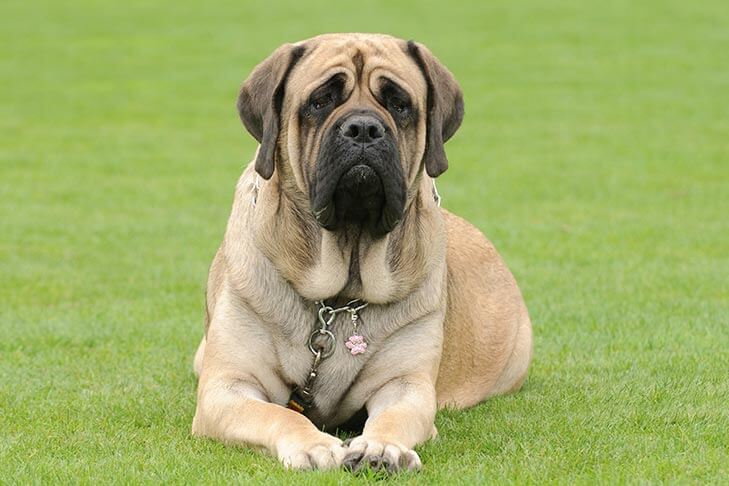
How to Judge the English Mastiff Dog Breed
The Mastiff is a large, massive, symmetrical dog with a well-knit frame. The impression is one of grandeur and dignity. Dogs are more massive throughout. Bitches should not be faulted for being somewhat smaller in dimensions while maintaining a proportionally powerful structure. A good evaluation considers positive qualities of type and soundness with equal weight. The height of the dog should come from the depth of body rather than from the length of leg. Proportion is rectangular, the length of the dog from the forechest to the rump is somewhat longer than the height at the withers. As the name Mastiff denotes, the dog should be massive and heavy-boned, with a powerful structure. Great depth and breadth is desirable.
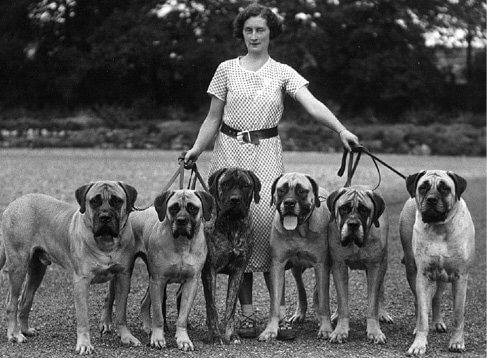
The head in general outline gives a massive appearance when viewed from any angle. Breadth is greatly desired, eyes set wide apart, medium in size, color the darker the better. Ears should be V-shaped, small and in proportion to the head. Skull is broad and somewhat flat between the ears. Forehead is slightly curved, with a furrow up the center of the forehead, showing marked wrinkles which are particularly distinctive when at attention. The brows are superciliary ridges, moderately raised. The proportion of the head is 1:2—one (1) for the muzzle (tip of nose to stop) and two (2) for the skull (stop to occiput). The muzzle is short and broad, with only a slight taper to the end of the nose. Black mask, colored the blacker the better. Scissors bite is preferred but a moderately undershot jaw should not be faulted providing the teeth are not visible when the mouth is closed. It should be noted that judges should examine the occlusion of the mouth to ensure a wry mouth is not present.

The Mastiff is not a “head breed,” it is a “working breed.” Their gait denotes power and strength. The rear legs should have drive, while the forelegs should track smoothly with good reach.
In motion, the legs move straight forward as the dog’s speed increases from a walk to a trot, the feet move in toward the center line of the body to maintain balance.
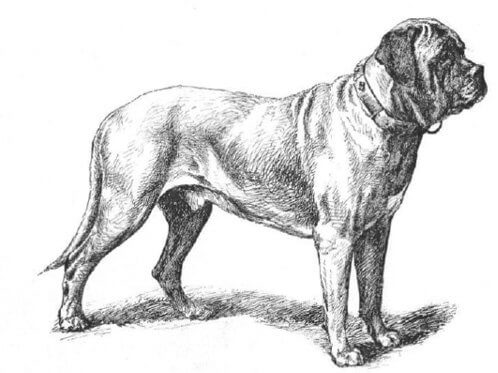
When judging temperament, there should be a combination of grandeur, good nature, courage, and docility. Dignity, rather than gaiety, is the Mastiff’s correct demeanor. Judges may find a Mastiff to be rather aloof, but should not condone shyness or viciousness. Conversely, judges should also be aware of putting a premium on showiness. The Mastiff is not typically a “showy breed.” Please do not penalize a dog for his/her reticent attitude. As long as the dog tolerates an examination, it is an acceptable attitude. There are three colors (fawn/apricot/brindle), all are judged equally with no preference for color.
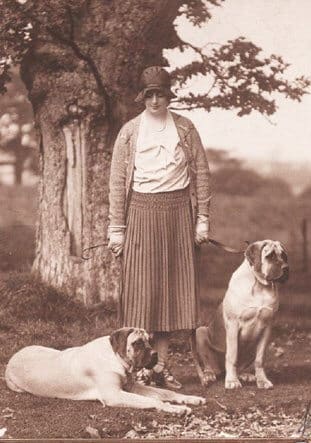
There are three easy landmarks to look for when judging the Mastiff: (1) a prominent sternum; (2) when in a stack, the elbow should be directly under the withers, denoting the dog has sufficient layback exhibiting a prominent pro-sternum; (3) plum-line dropped from the ischium (farthest most point of the hindquarters) will pass directly in front of the rear foot.
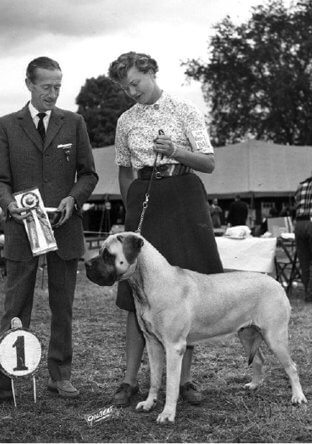
Judging the Mastiff should be an enjoyable experience. However, bring your spit towel and be prepared to put up with those of us who love and show our own beautiful dogs without benefit of being shown to their fullest potential. The Mastiff Club of America is always eager to answer your questions. Please visit our website at www.mastiff.org.
All information provided has come directly from the Mastiff History and Standard Judge’s Presentations.
How to Judge the English Mastiff Dog Breed
Diane Collings & Toni Hyland

Diane Collings has been involved with Mastiffs since 1978, when she attended her first MCOA National Specialty. She is a MCOA Life Member, 2x past MCOA President, past JE and JESC Chairperson, and she is currently an active JE Mentor/Presenter. Diane has bred/owned and handled close to 100 champions over the years, including one National Specialty winner, a National BOS winner from the Veterans Class, and MBISS winners. She continues to be active in the Conformation, Rally, and Obedience rings as well as Barn Hunt and FastCat. Diane splits her time in the ring on both sides of the leash as she currently holds provisional/active judging status on 26 Working Breeds and All-Breed Junior Showmanship. She had the immense honor and thrill of a lifetime judging the MCOA National in 2018 and she looks forward to judging at the Mastiff Club show in Denmark in September of 2024. Diane will be applying for the balance of the Working Group this summer and looks forward to adding other Group’s breeds to her resume.
AKC Judge #94897. Member in Good Standing: Mastiff Club of America, Life Member (JE Mentor), Great Dane Club of America (JE Mentor), Redwood Empire Mastiff Club, Life Member (BOD), Northern California Working Group Association (President).

Toni Hyland has owned and bred Mastiffs for over 30 years, including the 1978 National Specialty winner and several top-ranked dogs. She is an Honorary Life Member and a Past President of the Mastiff Club of America; Life Member and a Past President of the Redwood Empire Mastiff Club, Inc; and a Life Member, Mensona Kennel Club. Toni is a certified evaluator for AKC’s CGC Programs, Therapy Dogs International, and the Foundation for Service Dog Support, and she is an advisor for CHOMPs Therapy Dog Program. She holds a Ph.D. in Administration with dual majors in Business and Education, and she is retired after serving 30 years in private and public school administration. Her Mastiff, “Gideon,” age 4-1/2, and French Bulldog, “Oasis,” age 10, allow Toni to share their home in Salinas, California.